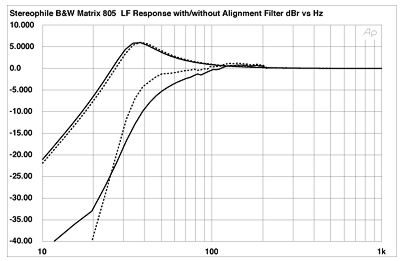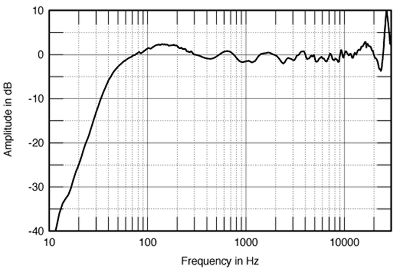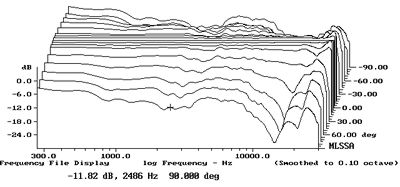| Columns Retired Columns & Blogs |
B&W Matrix 805 loudspeaker Measurements
Sidebar 3: Measurements
The 805's B-weighted sensitivity measured to specification at around 87dB/W/m, while its impedance plot (fig.1) revealed it to be a relatively easy load for an amplifier to drive. The cursor shows the minimum magnitude to be 5.2 ohms at just under 11kHz. The port is tuned to 40Hz, the frequency of the saddle between the two bass peaks, and the basic alignment is a little overdamped, this appropriate in view of the intended use of an electronic equalizer to flatten and extend the speaker's low-frequency response. The correction applied by this equalizer is mild, as can be seen from fig.2, and results in useful bass response to below 40Hz. The anechoic -6dB point is improved from 48Hz to 37Hz.

Fig.1 B&W Matrix 805, electrical impedance (solid) and phase (dashed). (2 ohms/vertical div.)

Fig.2 B&W Matrix 805, Bass Alignment Filter, electrical response (top); intrinsic loudspeaker LF rollout, calculated by DRA Labs' MLSSA program adding the complex responses of the woofer and port in the ratio of their diameters (bottom, solid trace); and overall LF response of loudspeaker when corrected by filter (middle, dashed trace) (5dB/vertical div.).
Fig.3 shows the acoustic responses of the two drive-units on the tweeter axis at a distance of 45". The crossover is just under 3kHz, and each drive-unit rolls out steeply outside of its passband. What breakup modes there are in the woofer cone are generally well-suppressed, therefore, though there is a hint of a well-damped mode just before crossover at 2.1kHz. To the left of fig.4 can be seen the individual nearfield responses of the woofer and port.

Fig.3 B&W Matrix 805, acoustic crossover on tweeter axis at 45", corrected for microphone response, with the nearfield responses of the woofer and port plotted below 300Hz and 1kHz, respectively.
Apart from a few probably inconsequential ripples, the overall response is very flat, as can be seen from the right-hand side of fig.4, which shows the 805's quasi-anechoic response averaged across a 30 degrees lateral window on the tweeter axis. There is a slight excess of energy in the top octave, which will add "air" to the speaker's sound; indeed, LG described the 805's treble as "extended and very open." The summed LF response is also shown in this graph. Again, the basic alignment can be seen to be a little overdamped.

Fig.4 B&W Matrix 805, anechoic response on tweeter axis at 45", averaged across 30 degrees horizontal window and corrected for microphone response, with the complex sum of the nearfield responses plotted below 300Hz.
Though the grille only covers the front of the woofer enclosure, it does accentuate a slight "lip" beneath the tweeter "bullet." I therefore performed an MLS measurement on the tweeter axis, with and without the grille. These are shown in fig.5—the lower response is with the grille—along with the difference between them (the top trace). Though the latter is relatively minor in degree, it would probably be best to leave the grilles off for serious auditioning.

Fig.5 B&W Matrix 805, anechoic response on tweeter axis at 45" with (bottom) and without grille (middle), both corrected for microphone response, and difference made by grille (top).
Vertically, there is very little change in the speaker's sound as long as the listener is on or below the tweeter axis. Move above the tweeter axis, however, and a deep suckout appears at the crossover frequency (fig.6). As is so often the case, this is a speaker that should never be judged by a standing listener. Laterally, the 805 features a well-controlled off-axis rollout in the treble (fig.7), which will contribute to the speaker's excellent imaging capability. And if you find the speaker to be just a little top-octave-heavy on-axis, fig.7 indicates that you can get a virtually flat treble by aiming the speakers straight ahead.

Fig.6 B&W Matrix 805, vertical response family at 45", normalized to response on tweeter axis, from back to front: differences in response 15 degrees-7.75 degrees above axis, reference response, differences in response 7.5 degrees-22.5 degrees below axis.

Fig.7 B&W Matrix 805, lateral response family at 45", normalized to response on tweeter axis, from back to front: differences in response 90 degrees-5 degrees off-axis, reference response, differences in response 5 degrees-90 degrees off-axis.
- Log in or register to post comments




































